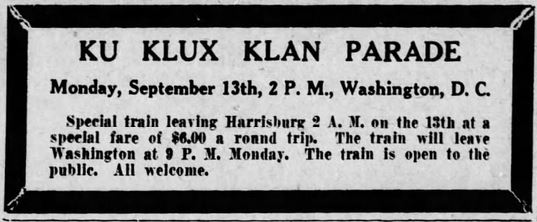Lykens Valley Ku Klux Klan Events Needing Further Research
Posted By Norman Gasbarro on August 25, 2017
Today’s post presents some events involving the Ku Klux Klan that were reported in the Elizabethville Echo. Each event needs further research.
The post is a continuation of the reporting on hate groups that were active in the Lykens Valley area in the years following the Civil War. It was a widely known fact that the third iteration of the Ku Klux Klan had a significant presence in the Lykens Valley and adjacent valleys during the early years of the 20th Century. This third iteration of the Klan was strongly white supremacist and was opposed to equal rights for African Americans, Catholics, Jews, and immigrants.
Those who allowed their names to be used in the newspaper had to know that they were supporting a group that was under investigation at the time by both federal and state authorities for criminal behavior, including intimidation and murder.
______________________________
From the “Curtin News” column of the Elizabethville Echo, 4 December 1924:
Some of our citizens attended the Klan meeting at Berrysburg on Saturday evening.
______________________________
From the “Berrysburg News” column of the Elizabethville Echo, 14 May 1925:
Some of the Klan members attended the meeting at Lykens last week.
______________________________
From the “Berrysburg News” column of the Elizabethville Echo, 18 June 1925:
Many of the town folks attended the Ku Klux Klan picnic held at Millersburg on Saturday.
______________________________
From the “Carsonville News” column of the Elizabethville Echo, 18 June 1925:
Those who attended the Klan celebration at Millersburg, Saturday, from this place, were: Arthur Schell, Clarence Fawber, Beatrice Wingard, William Etzweiler, Helen Schell, and Sylvia Fawber.
_______________________________
From the “Gratz News” column of the Elizabethville Echo, 23 July 1925:
Mr. and Mrs. Ray Martz and Mr. and Mrs. Harry Troxell attended the large Klan funeral for James Spangler at Lykens, on Saturday.
____________________________
From the Elizabethville Echo, 24 June 1926:
KLAN WILL MEET HERE SATURDAY NIGHT
On Saturday evening an educational meeting will be held by the Ku Klux Klan in Weaver’s Hall, South Market Street [Elizabethville], when Mr. C. S. Lewis, State Head and national speaker will make the address.
The meeting will open at eight o’clock and thrown open with a welcome to everyone.
____________________________
From the “Curtin News” column of the Elizabethville Echo, 23 September 1926:
Some of our citizens attended the band concert given by the Junior Ku Klux Band at Millersburg, Saturday evening.
______________________________
From the Elizabethville Echo, 16 June 1927:
TWO PARADES FOR MILLERSBURG
Next Saturday, June 25th, Millersburg will see two parades over its thoroughfares. Early afternoon, the babies will hold sway, when they have their parade under the auspices of the Community Nurse Association. Prizes will be awarded to the babies.
The same day the Ku Klux Klan of Dauphin County of Dauphin County will hold a picnic and meeting there, and at 6:30 o’clock in the evening will hold a parade in that town.
______________________________
From the Elizabethville Echo, 30 June 1927:
A number of our [Elizabethville] residents attended the Ku Klux Klan picnic and parade at Millersburg Saturday.
______________________________
From the Elizabethville Echo, 13 August 1931:
Tri-County Klan Picnic Here Saturday
A tri-county meeting and picnic will be held in Elizabethville‘s Memorial park, all day Saturday August 15th.
Competitive drills, addresses and naturalization ceremonies are scheduled. The meeting is for members in Northumberland, Lebanon and Dauphin Counties.
______________________________
The undated photograph at the top of this post was taken in front of a church in Matamoras, Pike County, Pennsylvania, and appeared on page 193 of the official history of the county.
 ;
;












